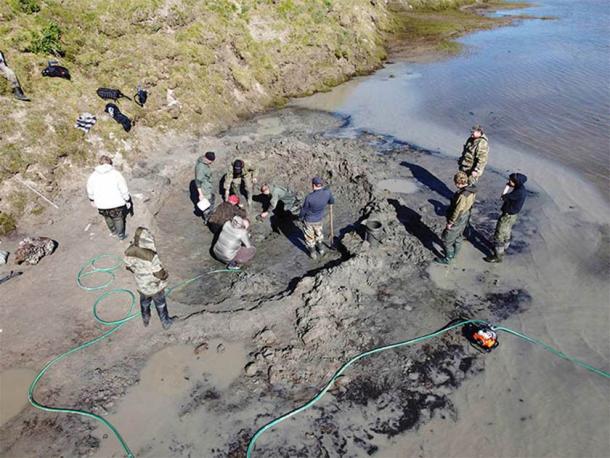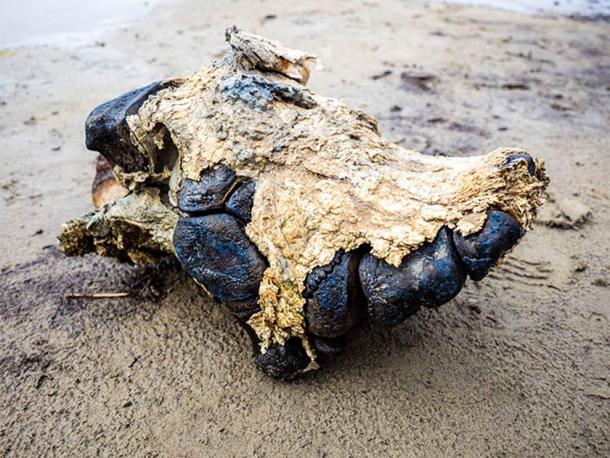https://www.ancient-origins.net/news-history-archaeology/siberian-mammoth-remains-0014074
This massive 10,000-year-old skull was just a small part of the Siberian mammoth remains discovery.
Source: Artem Cheremisov / Siberian Times

Part of the recently found Siberian mammoth remains and two members of the local indigenous community that first spotted the find.
(Image: Artem Cheremisov / Siberian Times )
Experts from the Scientific Centre for Arctic studies arrived at the scene where the mammoth remains were found and began an investigation. They managed to retrieve the 90% of the remains of the mammoth making it a spectacular discovery. The Daily Mail reports that the animal is going to be called ‘Tadibe after its finder Konstantin Tadibe, a reindeer herder living near the lake where the mammoth was found.’
Initial investigations have revealed that the mammoth was a 10-foot-tall male teenager that died about 10,000 years ago. Evgenia Khozyainova, who took part in the study, stated that 'We have one front and one hind foot well preserved, with tendons, soft tissues and pieces of skin,' according to the Daily Mail . Also found was the creature’s sacrum, some vertebrae and most of its tail, complete with pieces of skin and muscle. Archaeologist Andrey Gusev told The Siberian Times that ‘We managed to extract part of the skeleton, another part of it is still underwater and clay.’

Researchers at the sight where the Siberian mammoth remains were discovered. .
(Image: Artem Cheremisov / Siberian Times )
The mammoth remains taken from the watery bank of the lake have been safely stored away in a special refrigeration unit. Unfortunately, the animal’s brain was not preserved which was something of a disappointment. The Siberian Times states ‘so far there is only one preserved brain found in 2014 in Yakutia on a woolly mammoth called Yuka.’ Moreover, no tusks were retrieved in the recent find. They could have been taken by humans or simply fell off.
There is no evidence to suggest that the mammoth was killed by prehistoric hunters . Although marks on the bones indicate that at some time the remains of the prehistoric creature were scavenged. Dr Pavel Kosintsev speculates that ‘The mammoth may have become stuck in an ice crevice and been unable to escape’ reports the Daily Mail .

The yellow soft tissues preserved on bone piece that was part of the newly discovered woolly mammoth found in Siberia.
(Image: Artem Cheremisov / Siberian Times )
This Ancient Mammoth’s Soft Tissues Are Perfect for Cloning
It is exceedingly rare to find so many bones from one animal. Also found was some fossilized excrement, known as a coprolite. Dmitry Frolov, of the Arctic Research Centre, is quoted by the Daily Mail as saying that ‘The coprolite was left by this very mammoth.’ This discovery can provide scientists with considerable detail about the extinct mammoth’s eating habits.
However, this amazing find is particularly important because it provides superbly preserved dead mammoth DNA which can be used in cloning experiments . Teams, from Russia, USA, Japan, and South Korea are all desperately trying to clone ancient animals in test-tubes. The soft tissue found on Tadibe could provide the DNA key for researchers to bring woolly mammoths back to life, much like the movie Jurassic Park . The Russian federal government has funded a laboratory in Siberia to help them to win the race to clone a mammoth, which has become a matter of national prestige.
This post continues at: https://www.ancient-origins.net/news-history-archaeology/siberian-mammoth-remains-0014074


No comments:
Post a Comment
Stick to the subject, NO religion, or Party politics